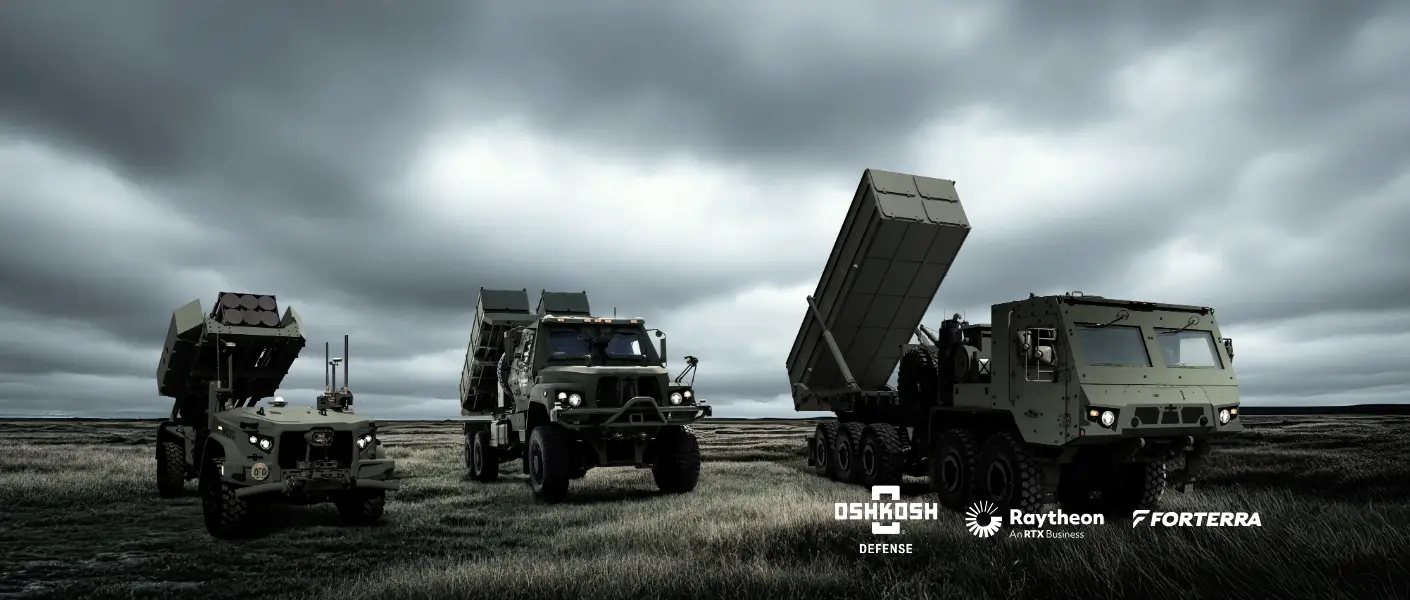Autonomous Launchers Make Impact As Army Requirements Grow
The Association of the U.S. Army’s (AUSA) annual symposium has seen some notable appearances by autonomous launchers, underscoring the service’s growing interest in this class of system. On show at the event were a new Family of Multi-Mission Autonomous Vehicles (FMAV) from Oshkosh Defense, as well as Raytheon’s DeepFires. Between them, these platforms can be armed with a wide variety of offensive and defensive weapons, including Tomahawk cruise missiles and Patriot surface-to-air missiles.

Extreme Multi-Mission Autonomous Vehicle (X-MAV)
The FMAV series from Oshkosh Defense comprises three different truck chassis that can carry a wide variety of weapons. The three vehicles are described as being “production-ready” by the manufacturer and comprise the following:
The largest of the FMAV series, the purpose-built X-MAV is able to support long-range munitions, including a podded launcher with four Tomahawk missiles. The 10×10 wheeled chassis offers off-road mobility, as well as integrated onboard power. Oshkosh is aiming the X-MAV at the U.S. Army’s Common Autonomous Multi-Domain Launcher Heavy (CAML-H) program.

In August, the Army revealed more details of CAML-H, which aims to integrate a launcher onto a 15-ton class chassis that will fire either Tomahawk missiles or the Patriot Advanced Capability 3 Missile Segment Enhancement (PAC-3 MSE) interceptor.
It is also worth noting here that the Army is already fielding the Typhon missile system, which includes tractor-trailer launchers capable of firing Tomahawks and SM-6s. Meanwhile, however, the Army has begun looking at smaller launchers that are easier to deploy as companions to Typhon, something we have reported on in the past.
Medium Multi-Mission Autonomous Vehicle (M-MAV)
The medium entrant in the family is based on the existing 6×6 Oshkosh FMTV A2. The M-MAV can be operated as an optionally crewed or fully autonomous launcher, equipped with the Multiple Launch Rocket System (MLRS) family of munitions. These munitions include the Guided Multiple Launch Rocket System (GMLRS), Precision Strike Missile (PrSM), Army Tactical Missile System (ATACMS), as well as future weapons like the Joint Reduced Range Rocket (JR3).

“M-MAV delivers advanced navigation, remote operation, and automated resupply capabilities to increase survivability, reduce crew burden, and enable dispersed, resilient fires formations,” Oshkosh said in its press release.
Light Multi-Mission Autonomous Vehicle (L-MAV)
The L-MAV is derived from the U.S. Marine Corps ROGUE-Fires and is a 4×4 autonomous carrier. It uses a modular design, so it can be rapidly configured for missions. These include counter-uncrewed aerial systems (C-UAS), electronic warfare, or resupply, for example. Examples of payloads shown at AUSA were the AeroVironment Switchblade 600 loitering munition and the Titan C-UAS.

“The Army has been clear on the need for autonomous, payload-agnostic platforms that are ready now,” said Pat Williams, chief programs officer at Oshkosh Defense, as he outlined the FMAV series. “The Oshkosh Family of Multi-Mission Autonomous Vehicles is engineered on proven tactical vehicles, with scalable autonomy and payload versatility to deliver what the Army needs today with the flexibility to adapt as the battlefield evolves.”
Raytheon DeepFires
Meanwhile, Raytheon revealed more details of its DeepFires autonomous launcher, which uses the Oshkosh FMTV A2 — the same platform employed by the middle-tier M-MAV. Raytheon has already been using the FMTV A2 platform for its DeepStrike autonomous launcher, which you can read more about here.

As for DeepFires, this has been designed for modularity, able to pivot very quickly from offensive or defensive fires. The vehicle is also designed for optionally crewed or fully autonomous operations and has already been tested.
Weapons payloads for DeepFires range from the AIM-9X Sidewinder for air defense all the way up to the Tomahawk. Raytheon has been tight-lipped about exactly how many rounds of each type of missile can be loaded on a single vehicle, although a promotional video from the company shows one of the trucks carrying two containerized Tomahawk rounds. Meanwhile, one of the DeepFires vehicles exhibited at AUSA was loaded with four Patriot missiles.

Speaking to media, including TWZ, at AUSA, Brian Burton, vice president, Precision Fires and Maneuver at Raytheon, hinted at the possibility of carrying significant numbers of smaller weapons, like the AIM-9X:
“One of the big things when we got feedback from the warfighters was more magazine depth. Not a surprise. We hear that all the time. So, this is something that we’ve been looking at from the very beginning — how do we increase that? So, it can vary, but you’re looking at a significant increase in magazine depth, and that’s obviously important to whether you’re putting additional fires down range or it’s just defending your area.”
Another key requirement that emerged from Army feedback on DeepFires was onboard vehicle power. Not only does the onboard power allow for the handling, including reloading, of missile rounds, but it also provides additional mobility, since the vehicle is not tied to a separate generator. “That was a key piece that came out of touchpoints with the customer and feedback that we incorporated, and they’re really excited about that,” Burton said.

Also built into the DeepFires concept, from the outset, is air transportability, including by the C-130 airlifter. “We wanted to put something together that could be very mobile,” Burton explained, “and [to] be able to get on that [C-130] platform gives the warfighters a lot more flexibility as to where they can get to and how quickly they can get there, and how quickly they can get out.”
The air transportability of DeepFires also helps answer broader U.S. military concerns about establishing diverse, distributed logistics chains. These are seen as an essential requirement for supporting future operations in contested environments, especially in the context of a potential future high-end conflict, including in the Pacific.
The relevance of DeepFires to the Indo-Pacific theater is something that was referenced directly by Scott Sanders, chief growth officer at Forterra, the company that provides the autonomous capabilities for the system. “The only thing more terrifying than a fleet of unmanned vehicles hiding in the Indo-PACOM somewhere is probably a B-21,” he said.

At the same time, a system such as this could be highly relevant for contingencies in the European theater, where long-range precision fires are increasingly seen as necessary to offset potential Russian aggression. In the near future, it may also be possible that Ukraine will need a launcher of this kind, should it be approved to receive Tomahawks. Ukraine has some experience in this area, having already been successful with remote Patriot launcher operations.
For autonomous operations, an operator is able to control between one to six DeepFires vehicles, depending on theater requirements. The vehicles can be controlled independently, using a route-following approach. In this mode, they will be given endpoint goals where the firing battery is required, and they will self-navigate from point A to point B.
Alternatively, Raytheon is proposing a “follower technique,” in which the first vehicle is crewed. “You can pick up a string of [uncrewed] vehicles behind you, move really quickly to your firing point, disperse via waypoint-based navigation into your firing points, and regroup,” Burton explained. In terms of command and control, DeepFires is intended to be “relatively comms agnostic,” Burton said, meaning that it can be operated using a variety of different networks and bandwidths, including via satellite link.
When asked whether DeepFires is being pitched directly at the Army’s Common Autonomous Multi-Domain Launcher (CAML) program, Burton said that Raytheon is “100 percent tracking and pursuing the CAML opportunity. They’ve seen this as an opportunity, and they are moving out quickly to get this capability into their hands.”

Since DeepFires is designed around scalability, Burton said that the launcher could be optimized for both the Medium and Heavy segments of that program: CAML-M and CAML-H.
“We can scale and, working with Oshkosh and with Forterra, bring that to a larger, heavier vehicle, if that’s what the demand and the means are for the Army,” Burton observed.
Other options for DeepFires could include the possibility of a separate autonomous launcher that would be dedicated to air defense, building upon the planned integration of the AIM-9X and Patriot on the basic platform. “Certainly, we’re looking at both,” Burton said, noting that Raytheon also provides a lot of in-house air defense capabilities, including counter-uncrewed aerial systems (C-UAS). These include the Coyote Block 2, a jet-powered drone-like loitering interceptor that the Army currently fields as part of the mobile and fixed-site versions of its Low, Slow, Unmanned Aircraft Integrated Defeat System (LIDS).

With a growing focus on battlefield survivability in the face of drone proliferation, of the kind that’s been seen in the war in Ukraine, Raytheon says it’s considering C-UAS capabilities that are indigenous to the platform itself, or mounted on a different, dedicated platform.
The appearance of these somewhat-related autonomous launchers at AUSA points again to the U.S. military’s interest in flexible, highly mobile, very hard to target systems that offer significant reach and relevant magazine capacity, and which are optimized for future scenarios in the Indo-Pacific region.
Already, the Army has explored this concept with an uncrewed derivative of the HIMARS launcher vehicle called the Autonomous Multi-domain Launcher (AML).

Building on the prototype AML, the Army has since put out a contracting notice outlining a potential family of uncrewed launcher vehicles — the aforementioned CAML, which the Oshkosh and Raytheon options may well end up competing for.
Various kinds of autonomous launchers would be particularly relevant in future expeditionary or distributed operations, especially across the broad expanses of the Pacific during a future major conflict with China, or for trying to deter one. This is a reality that is clearly not lost on the various companies presenting systems in this class at AUSA this week.
Contact the author: [email protected]

